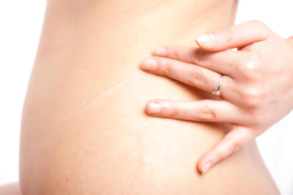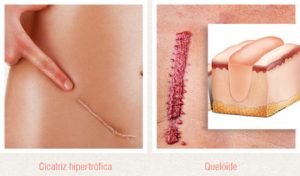 Scars can be very uncomfortable, especially if they are thick, dark or in very apparent locations. They can often be improved through another surgical procedure. But remember, to correct a scar, we need to make a new scar; it will never disappear completely. We aim to be as careful as possible to make the new scar more imperceptible.
Scars can be very uncomfortable, especially if they are thick, dark or in very apparent locations. They can often be improved through another surgical procedure. But remember, to correct a scar, we need to make a new scar; it will never disappear completely. We aim to be as careful as possible to make the new scar more imperceptible.
1. What type of anesthesia is used in scar removal?
It will depend on the scar’s extent. Minor scars can be corrected by using local anesthesia. Larger scars may require sedation.
 2. What is the difference between hypertrophic and keloid scars?
2. What is the difference between hypertrophic and keloid scars?
The hypertrophy scar is more common. It is characterized by a red and raised scar, but still has the design of the previous scar. It usually appears in areas that have been under tension during wound healing. The keloid is caused by excessive scarring. The individual who is predisposed to it often produces more scar tissue than necessary, depositing excess collagen in the scar. It is more common in people with dark skin, Orientals and adolescents / young adults. The body regions that are most at risk for keloids are the earlobes, the middle line of the chest and shoulders. It causes massive scars, beyond the limits and drawings of the original scar; It can be red, brown and cause a lot of itching.
3. If I already have a good scar that I did earlier, am I at risk of forming keloids in another surgery?
The risk is lower, but it still exists. Remember that the keloid is more related to some parts of the body than others.
4. What is the indicated treatment for keloids?
There are several treatment option, such as:
• Corticosteroid infiltration in the scar
• Betatherapy (superficial radiotherapy that acts only on the skin. It is especially suitable for keloids and hypertrophic scars) • Removal of keloid scarring and performing another scar
• Silicone plates for compression
• Massage with silicone oils
5. If I remove the keloid and make a new scar, do I run the risk of having a keloid again?
Yes. If surgery is performed without any additional treatment, there are risks of keloid recurrence. So, whenever we remove the keloid, we should associate this action with another treatment such as corticosteroid infiltration or betatherapy.
6. Does the keloid appear soon after surgery?
No. The keloid appears later because it is an excess of scar tissue. After a few months when the scar is already established, the patient who has this predisposition will continue to produce collagen on it, which makes it bulky and deformed. This usually happens after 3 to 6 months after surgery
7. When will the stitches be removed?
For this type of surgery we use absorbable sutures, that is, wires that are degraded by the body after a few weeks. Thus, the stitches do not need to be removed, they will disappear by themselves.
8. After a scar correction, when will I have the end result of it?
We must remember that all scars go through the following stages:
• Initial Period: corresponds to the first 30 days. The scar will look good, thin and clear. During this period, we usually use a bandage with adhesive to reduce local tension
• Recent period: These are the first 12 months of a scar. In it, the scar may become higher and change color (red, brown). It is the natural process of healing, but we can soften it with some care offered to patients.
• Late Period: After the scar is 12 to 18 months old, it will become lower, thin and clear, becoming less noticeable. That is the final appearance of a scar.

